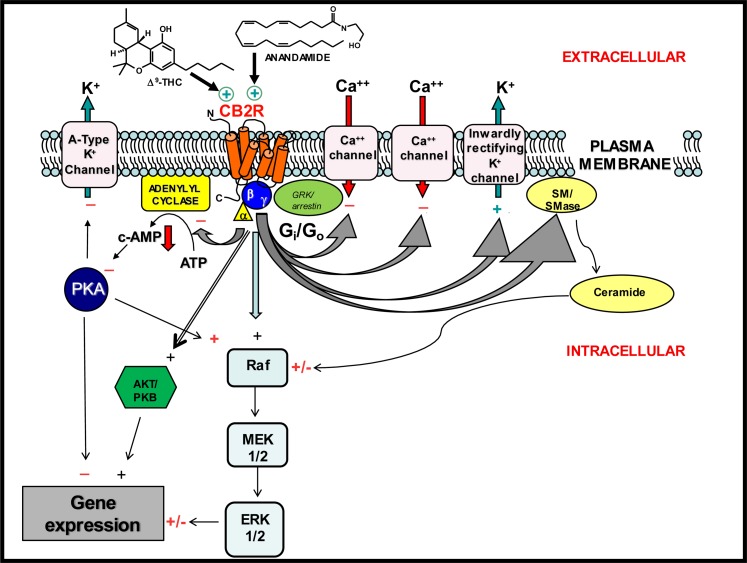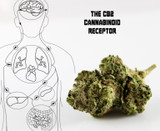When you consume any cannabinoid, it works in the body through the endocannabinoid system. This system has two main types of cannabinoid receptors. The first to be discovered is the CB1 receptor that is associated with THC (a plant cannabinoid) and anandamide (AEA; an endocannabinoid produced naturally by the body) [6]. Later, the CB2 receptor (aka CBR2; cannabinoid receptor type 2) was discovered.
The cannabinoids CBD and THC can bind (weakly/partially) to this receptor and so can the terpene beta-caryophyllene. Surprisingly, CBD does not mainly work via CB2, it has more action on other indirect body systems like 5-HT. Still, understanding the CB2 receptor is key to understanding your body’s endocannabinoid system.
Table of Contents
Overview of CB2
- CB2 activation does not produce a “high” like activating CB1 with THC
- CB2-binding compounds could have medicinal benefits
- Promotes homeostasis (balance) and regulates daily body functions
- In the endocannabinoid system, CB1 and CB2 are distributed through the central and peripheral nervous systems
What Are Cannabinoid Receptors?
On the outer layer of a cell, there is a membrane (like skin) that is embedded with protien “studs.” These receptor proteins match up like a lock and key with different compounds like cannabinoids and signal molecules. Some compounds bind to them directly to trigger a reaction, while others will send signals indirectly by triggering other systems that release signal molecules.
In this way, the endocannabinoid system is able to sense signals and then send out signals to other body systems and create a larger effect. Molecules that bind to receptor proteins are commonly called “ligands.” The cascade of reaction that ligands can initiate is a large part of how things get done in our bodies. Shortages or surpluses of ligands can throw the body out of balance which is why many people take supplements to maintain balance in their bodies.

CB2 receptor activation diagram
'Figure 1' from Dhopeshwarkar, A., & Mackie, K. (2014). 'CB2 cannabinoid receptors as a therapeutic target-what does the future hold?'
What Does the Endocannabinoid System Regulate?
- Temperature regulation
- Mood, memory, sleep
- Pleasure sensation
- Reproduction
- Pain sensation
- Immunity functions
- Psychological reward system
CB2 Endocannabinoid Signaling: How Does CB2 Work?
The CB1 receptor dominates locations like the central nervous system and brain. The CB2 receptor is more abundant in the peripheral nervous system [5, 6]. Cannabinoid receptor 2 was initially found in the spleen. The discovery was published quite recently in 1993. Like CB1, CB2 is a “G-protein coupled receptor (GPRC)” which simply means that the G-protein unit is the biological mechanism that is triggered when CB2 is activated and passes on the message for the body to do something (such as stop breaking down serotonin).
GPRCs are so common that about 34% of FDA-approved drugs work on them as a therapeutic target. Here is an extremely simplified overview of how this works:
- CBD, beta-caryophyllene, or the endocannabinoid 2-AG are consumed/produced
- They bind to CB2
- CB2 changes shape and sends signals out to other cells
- Other cells get the signals and change what they are doing
What Does CB2 Do?
When CB2 receptors are activated, it leads to inhibition of neurotransmitters (chemical signals cells use to communicate with the body) [5]. CB2 receptor activation also influences immune system cells and can inhibit them from secreting inflammatory causing compounds called “cytokines.”
Along with partial binding from CBD, and binding from beta-caryophyllene, the CB2 receptor also binds the endocannabinoid 2-AG and the synthetic cannabinoids like HU-308 [1, 6]. This endocannabinoid, like anandamide for CB1, is naturally produced by the body. If the body does not naturally produce enough of it, a similar plant cannabinoid (phytocannabinoid) can be consumed to compensate for the shortage.
The clinical effect of the various cannabis-based medications rests primarily on activation of the endogenous cannabinoid receptor system with predominantly centrally situated CB1 receptors and peripherally located CB2 receptors.
- From Grotenhermen, F., & Müller-Vahl, K. (2012). 'The therapeutic potential of cannabis and cannabinoids.'
What Are The Benefits of CB2?
CB2 can be very effective as a target for treating issues like inflammation and is thought to be even stronger than aspirin for anti-inflammatory action. Inflammation is a common aspect of many diseases, conditions, and injuries. CB2 receptors are distributed very widely in the body as well (digestive tract, joints, skin), so the receptor is a very good target for treatments. Here and the benefits that researchers have associated with CB2:
- Potential to relieve symptoms of Crohn’s disease, colitis, and inflammatory bowel syndrome (IBS) [6]
- Joint pain and rheumatoid arthritis may also benefit from CB2 ant-inflammatory action
- CB2 can influence the brain’s reward system and is a novel target for addiction therapy [3]
- Could benefit skin conditions like acne and rashes [5]
- May also benefit neurological, psychiatric, and cardiovascular issues [5]
- CB2 can produce analgesic effects and reduce the sensation of pain [4, 6]
- CB2 is thought to also promote the healthy functioning in the heart, liver, kidneys, and bones
The effects of CBD are different from the effects of activating or inhibiting CB2 receptors because CBD works on additional systems like 5-HT. Not all CBD benefits come from CB2 receptors.
Final Thoughts on Cannabinoid Receptor Type 2
CB2 is not the “CBD receptor” that it has been wrongly portrayed as. Instead, this receptor is more strongly linked to the terpene beta-caryophyllene. This is a major consideration for hemp flower and CBD oil customers. The potency of the CBD in a product is truly just one aspect. Using full-spectrum products that have beta-caryophyllene will have more activity with CB2 receptors than using a product that is high in CBD.
It is also important to differentiate “CB2 benefits” and “CBD benefits.” While some are the same, they are not mutually exclusive. When we talk about medical treatments that target CB2, we do not mean that CBD is a medical treatment for those conditions. Retail CBD products are not intended to treat or cure any medical condition and are not approved for medical use (except the prescription Epidiolex). There are many synthetic cannabinoids that have more action on CB2 than CBD. Much research on CB2 benefits utilizes those synthetic cannabinoids instead of CBD.
References
- Dhopeshwarkar, A., & Mackie, K. (2014). CB2 cannabinoid receptors as a therapeutic target-what does the future hold? Molecular pharmacology, 86(4), 430–437.
- Grotenhermen, F., & Müller-Vahl, K. (2012). The therapeutic potential of cannabis and cannabinoids. Deutsches Arzteblatt international, 109(29-30), 495-501.
- Katona, I., & Freund, T. F. (2012). Multiple functions of endocannabinoid signaling in the brain. Annual review of neuroscience, 35, 529-558.
- Kaur, R., R Ambwani, S., & Singh, S. (2016). Endocannabinoid system: a multi-facet therapeutic target. Current clinical pharmacology, 11(2), 110-117.
- Mechoulam, R., & Parker, L. A. (2013). The endocannabinoid system and the brain. Annual review of psychology, 64, 21-47.
- Turcotte, C., Blanchet, M. R., Laviolette, M., & Flamand, N. (2016). The CB2receptor and its role as a regulator of inflammation. Cellular and molecular life sciences: CMLS, 73(23), 4449–4470.


